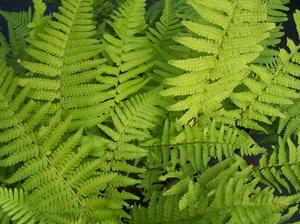View All Plants :: View All FERNS :: View All SHADE PERENNIALS
Dryopteris pseudo-filix mas
Mexican Male Fern
Plant Type:
FERNSDryopteris pseudo-filix mas – Mexican Male Fern is one handsome and considering its native haunts of Mexico and Guatemala surprisingly hardy. Rather rare, it comes from damp, higher elevations growing under forest canopy. The higher elevation insures its greater hardiness. Some of Mexican Male Fern's salient features is that it is similar in look to Dryopteris wallichiana, another handsome fern (are there any that are not?!) but larger growing producing new fronds throughout the growing season. In the southern end of its range mature fronds remain evergreen in winter. This trait may not be realized in the north though fronds will likely hold up through the winter solstice. Dryopteris pseudo-filix mas habit is to clump and is perfectly content in open shade, dappled conditions and with some morning sun – perhaps more sun-tolerant than we surmise. Beautiful, established specimens.
From Marianne H. (IL) on 9.2.2015:
HOLY MOLEY!!My ferns just arrived and they are enormous — and beautiful and SO healthy. I have never received plants like these through the mail. THANK YOU!!
Characteristics and Attributes for Dryopteris pseudo-filix mas
Season of Interest (Foliage)
- Spring / Summer / Autumn
Nature Attraction
- Deer Resistant
Light
- Morning Sun / Afternoon Shade
- Dappled Shade
- Shade
Attributes
- Foliage
- Woodland
- Evergreen
- Cutting Garden
- Massing
- Specimen
Growth Rate in the Garden
- Medium
Soil
- Organic
- Draining
- Moist
- Fertile
- Humus Laden
Origins
- Mexico
- Guatemala
Genus Overview: Ferns
Ferns. The easy, elegant and exceptional beauty of ferns cannot be understated. All ferns, beautiful as specimens unto themselves, are extraordinary in their simple ability to provide rich contrast to other companions wherever their requirements befit.
Habituated to so many environments many of the ferny pteridophytes – vascular plants that reproduce by spores, not seeds - are woodland denizens thriving on the cool, damp forest floor like the Christmas Fern, Polystichum acrostochoides with some preferring the wetter disposition of bogs, swamps, and stream banks such as Osmunda cinnamomea. Others will colonize gritty soils in shade or sun like the running Hay-scented fern, Dennstaedtia punctilobula and many among the Cheilanthes. Some are tough enough to grasp a foothold in the crack of a rock, these are lithophytic, as with Asplenium trichomanes. And some – most of these tropical in origin are truly epiphytic, clinging to tree bark as they unfurl their fronds from embryonic croziers to reach into the forest light such as the primitive looking Staghorn Fern, Platycerium bifurcatum or Rabbit-foot Fern, Davallia fejeensis .
And many have historic medicinal uses such as Maidenhair Fern, Adiantum pedtaum – this from medicinalherbinfor.org, “Expectorant, anti-rheumatic, demulcent, pectoral, refrigerant, tonic”... Native Americans throughout North America used maidenhair as a hair wash to make their hair shiny.” And in a more Bacchanalian use: as a flavoring in liquers.
There was probably something fern-like, an ancient ferny forebear(s) if you will, living during the Devonian some 60 to 70 million years ago. Ferns, some we still recognize today are descendents from an ancient order whose reign during the Carboniferous Age is legend, where giant horsetails and monstrous club mosses still populate the misty recesses of our dreams... and whose contemporary plundering by Homo sapiens in the vast burning of fossil fuels is altering our climate at such an alarming rate that more among the many are beginning to query as to the potential for another mass extinction – the closing chapter of another age, a blip in the larger context of perceived time. But I digress....
All our offerings are well-rooted pot grown divisions in 5 pint squares unless otherwise indicated. The quality we offer make them worth the money. We think you will agree.


